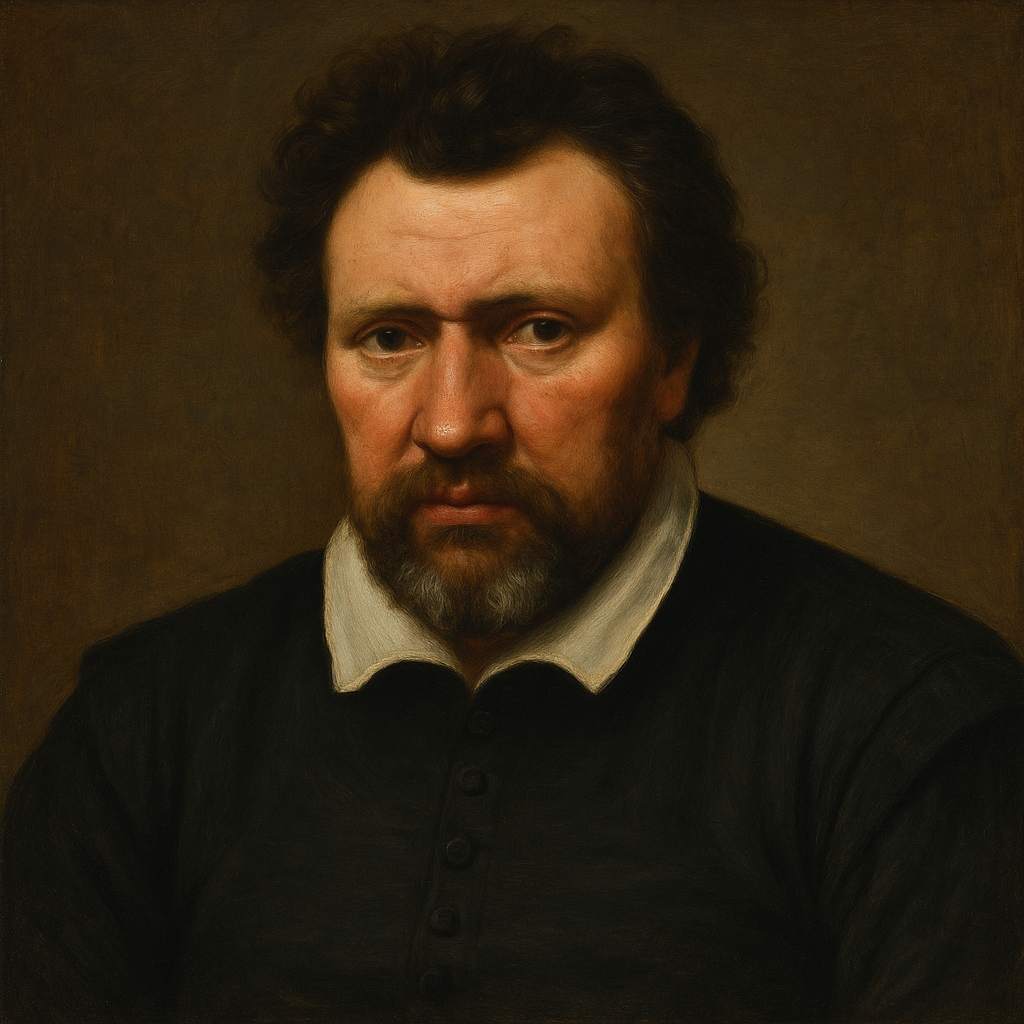To Celia
Ben Jonson
1572 to 1637

Drink to me only with thine eyes,
And I will pledge with mine;
Or leave a kiss but in the cup,
And I’ll not look for wine.
The thirst that from the soul doth rise
Doth ask a drink divine;
But might I of Jove’s nectar sup,
I would not change for thine.
I sent thee late a rosy wreath,
Not so much honouring thee
As giving it a hope, that there
It could not withered be.
But thou thereon didst only breathe,
And sent’st it back to me;
Since when it grows, and smells, I swear,
Not of itself, but thee.
Ben Jonson's To Celia
Introduction
Ben Jonson's "To Celia" stands as a paragon of Renaissance lyric poetry, embodying the intricate fusion of classical allusion and innovative metaphysical conceit that characterized the literary landscape of 17th-century England. This deceptively simple poem, composed of two stanzas of eight lines each, unfolds a complex tapestry of love, desire, and transcendence that has captivated readers for centuries. Through a meticulous examination of its form, imagery, and thematic resonance, we can discern the profound artistry that elevates this work beyond mere romantic verse to a sublime meditation on the nature of love and its transformative power.
Historical and Literary Context
To fully appreciate the nuances of "To Celia," one must situate it within the broader context of Jonson's oeuvre and the literary milieu of his time. As a contemporary of Shakespeare and a formidable dramatist in his own right, Jonson was deeply versed in classical literature and the emerging aesthetics of the English Renaissance. This poem, likely composed in the early 17th century, reflects the prevailing Neo-Platonic philosophy that viewed love as a spiritual force capable of elevating the soul.
The influence of Catullus and other Roman lyric poets is evident in Jonson's economical yet evocative language, while the poem's conceptual depth aligns it with the metaphysical tradition soon to be exemplified by poets like John Donne. "To Celia" thus stands at a crucial juncture in English poetry, synthesizing classical forms with innovative metaphysical exploration.
Form and Structure
The poem's structure is deceptively simple, consisting of two octaves with an alternating rhyme scheme (ababcdcd). This formal regularity belies the complex interplay of ideas and images within. The alternating long and short lines create a rhythmic undulation that mirrors the poem's thematic oscillation between earthly and divine love.
Jonson's mastery of meter is evident in his subtle variations of iambic tetrameter and trimeter, which lend the poem a musical quality reminiscent of a drinking song or toast. This auditory charm serves to underscore the poem's central conceit of love as an intoxicating force.
Imagery and Symbolism
The poem's opening lines, "Drink to me only with thine eyes, / And I will pledge with mine," establish the central metaphor of love as a form of spiritual imbibing. This image is both startlingly original and deeply rooted in classical tradition, evoking the Greek concept of "ophthalmia," the belief that love enters through the eyes.
Jonson extends this metaphor throughout the first stanza, juxtaposing the earthly pleasure of wine with the divine nectar of the beloved's gaze. The reference to "Jove's nectar" not only elevates the beloved to a godlike status but also situates the poem within a classical framework, inviting comparisons to mythological tales of love and transformation.
The second stanza introduces a new set of images centered around the "rosy wreath," a symbol rich with connotations of love, beauty, and the fleeting nature of both. The transformation of this wreath from a potentially withering token to an ever-blooming emblem of the beloved's breath represents a profound alchemical change, suggesting the power of love to transcend physical decay.
Thematic Analysis
At its core, "To Celia" explores the transformative nature of love and its capacity to elevate the mundane to the divine. The poem posits a love that transcends physical desire, seeking instead a spiritual communion that satisfies "The thirst that from the soul doth rise." This Neoplatonic conception of love as a force for spiritual elevation is central to Renaissance philosophy and poetry.
However, Jonson's treatment of this theme is far from conventional. By grounding his metaphysical conceits in vivid, sensual imagery, he creates a tension between the physical and spiritual aspects of love. The beloved's breath, capable of bestowing eternal life on a simple wreath, becomes a metaphor for the soul-sustaining power of true love.
Furthermore, the poem subtly explores the theme of reciprocity in love. The speaker's willingness to forgo wine for the beloved's gaze or kiss suggests a mutuality of affection, while the returned wreath, now imbued with the beloved's essence, implies a cyclical exchange of love and inspiration between the lovers.
Language and Rhetoric
Jonson's linguistic prowess is on full display in "To Celia." The poem's diction is carefully chosen to create a sense of intimacy and immediacy, with direct address ("Drink to me") and personal pronouns drawing the reader into the lover's plea. The use of archaic forms like "thine" and "doth" lends a timeless quality to the verse, reinforcing its connection to classical tradition.
Rhetorical devices abound, from the hyperbole of preferring the beloved's gaze to "Jove's nectar" to the paradox of a wreath that grows more vibrant after being returned. The poem's final lines, with their emphatic "I swear," create a sense of testimony, as if the speaker is bearing witness to love's miraculous power.
Comparative Analysis
"To Celia" invites comparison with other works of the period, notably Shakespeare's sonnets and the poems of John Donne. While it shares the Shakespearean preoccupation with love's ability to confer immortality, Jonson's approach is more grounded in tangible imagery. Unlike Donne's often tortured explorations of love and faith, Jonson presents a more harmonious vision of love's transformative power.
The poem also bears comparison to classical works, particularly Catullus 51, which similarly explores the intoxicating effects of the beloved's presence. However, Jonson's innovation lies in his fusion of classical allusion with distinctly English sensibilities and contemporary philosophical concerns.
Reception and Influence
"To Celia" has enjoyed enduring popularity, both as a poem and as a song (it was set to music in the 18th century and remains a popular art song). Its influence can be traced through the Cavalier poets of the mid-17th century and beyond, shaping the development of the English love lyric.
Critical reception has generally been favorable, with scholars praising Jonson's technical mastery and the poem's perfect balance of sensual and spiritual elements. Some modern critics have explored the poem's gender dynamics, noting the active role assigned to the female beloved, whose gaze and breath possess transformative power.
Conclusion
In "To Celia," Ben Jonson achieves a remarkable synthesis of classical learning, Renaissance philosophy, and poetic innovation. Through its intricate play of imagery, form, and idea, the poem transcends the conventions of the love lyric to become a profound meditation on the nature of love itself. Jonson's achievement lies not merely in his technical mastery, though that is considerable, but in his ability to render abstract philosophical concepts in vivid, sensual terms that continue to resonate with readers across the centuries.
The poem's enduring appeal testifies to its universal themes and the timeless power of its central conceit: that true love, like the most rarefied wine or the breath of the divine, has the power to intoxicate, transform, and ultimately transcend the limitations of our mortal existence. In its mere sixteen lines, "To Celia" encapsulates the very essence of Renaissance humanism, celebrating the power of human love to approach the divine while remaining grounded in the sensual world. It stands as a testament to Jonson's genius and a cornerstone of the English poetic tradition.
This text was generated by AI and is for reference only. Learn more
Want to join the discussion? Reopen or create a unique username to comment. No personal details required!



Comments
No comments yet. Be the first to comment!